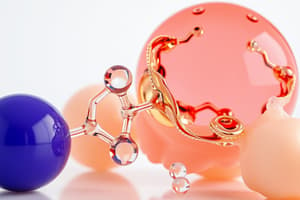Podcast
Questions and Answers
What primarily does chemistry deal with?
What primarily does chemistry deal with?
- Biological reactions in living organisms
- The study of environmental impacts
- The financial aspects of chemical production
- Properties, composition, and structure of substances (correct)
Which statement about electronegativity is correct?
Which statement about electronegativity is correct?
- Electronegativity is constant for all elements
- Electronegativity increases across a period (correct)
- Electronegativity increases down a group
- Electronegativity decreases across a period
What characterizes ionic bonds?
What characterizes ionic bonds?
- Occurs when the difference in EN is less than 2
- Involves complete charges and separate ions (correct)
- Involves sharing of electrons
- Formed between neutral atoms
Which of the following pairs of elements would most likely form an ionic bond?
Which of the following pairs of elements would most likely form an ionic bond?
What is NOT a property that chemistry studies?
What is NOT a property that chemistry studies?
How are atoms involved in chemical bonds?
How are atoms involved in chemical bonds?
What transformation is NOT included in chemistry's study of substances?
What transformation is NOT included in chemistry's study of substances?
What is the role of electronegativity in chemical bonding?
What is the role of electronegativity in chemical bonding?
Flashcards
Electronegativity
Electronegativity
The ability of an atom to attract electrons in a chemical bond.
Ionic Bond
Ionic Bond
A chemical bond formed by the electrostatic attraction between oppositely charged ions.
Chemistry
Chemistry
The science that studies the composition, properties, and transformations of matter and the energy changes involved.
Matter
Matter
Signup and view all the flashcards
States of Matter
States of Matter
Signup and view all the flashcards
Chemical Bonds
Chemical Bonds
Signup and view all the flashcards
Atomic Number
Atomic Number
Signup and view all the flashcards
Chemical Properties
Chemical Properties
Signup and view all the flashcards
Study Notes
Lecture 1 (General Chemistry)
- Lecture presented by Dr. Dina Amin, a lecturer of pharmaceutical organic chemistry
- The lecture is part of a General Chemistry course, likely at BNS University's Faculty of Pharmacy
Lecture Rules
- Attendance is required (time and number)
- Phones must be silenced, except for an emergency call
- Students should be prepared to leave and have questions ready
- Exit the class in case of emergency only twice
Chemistry Fundamentals
- Chemistry studies various substance properties (physical and chemical) and composition
- It examines the structure of substances like ethyl alcohol (CH3CH2OH)
- Chemical transformations, such as melting, evaporation, and condensation, are part of chemistry
- Energy changes (absorbed or released) during these reactions are also studied
- Chemistry covers the interactions between atoms and molecules
- Substances can occur naturally or be artificially produced
- These substances contain atoms.
Matter
- Matter is anything that has mass and occupies space
- Pure substances have a definite composition and distinct properties
- Mixtures contain two or more substances, which retain their individual properties
- Heterogeneous mixtures have a non-uniform composition
- Homogeneous mixtures have a uniform composition throughout
Classification of Substances
- Examples of substances and their classifications are listed, including:
- NaCl (compound, homogeneous mixture)
- Salt Water (homogeneous mixture)
- Iron (element)
- Sugar (compound)
- Air (homogeneous mixture)
- Helium (element)
- Water (compound)
- Salad (heterogeneous mixture)
Element, Compounds & Molecules
- Elements are substances that cannot be broken down into simpler substances by chemical means
- Compounds are made of two or more chemically combined elements in fixed proportions
- Molecules consist of atoms of different elements
- Polyatomic molecules have more than two atoms in a molecule
- Diatomic molecules have two atoms
- Examples of elements are C, Al, and Ti
- Examples of polyatomic molecules are S8 and O3
- Examples of diatomic molecules are O2 and H2
- Examples of molecules are H2O and H2SO3
Matter States
- Matter exists in three states: solid, liquid, and gas
- The states differ based on the distance between the molecules
Salts
- Salts are inorganic compounds
- Salts contain acid radicals (anions) and basic radicals (cations)
- Anions are negatively charged ions
- Cations are positively charged ions
Electronegativity
- Electronegativity (EN) is the tendency of an atom to attract electrons
- EN increases across periods (left to right) and decreases down groups (top to bottom)
- Specific EN values are tabulated for different elements
- EN values for Hydrogen (H), Lithium (Li), Sodium (Na), Potassium (K), Beryllium (Be), Carbon (C), Nitrogen (N), Oxygen (O), Fluorine (F), Chlorine (Cl), Bromine (Br), and Iodine (I), are provided .
Chemical Bonds
- Chemical bonds form between atoms to create new compounds.
- Three types of chemical bonds are discussed: Ionic, Covalent Polar, and Covalent Non-Polar
- Ionic bonds form when the difference in electronegativity (ΔEN) between atoms is greater than 2
- Covalent Polar bonds form when the difference in electronegativity(ΔEN) is between 0.5 and 2
- Covalent Non-Polar bonds form when the difference in electronegativity (ΔEN) between atoms is between 0–0.5 . Examples of different atoms and compounds are presented.
Studying That Suits You
Use AI to generate personalized quizzes and flashcards to suit your learning preferences.




